There are few gardening techniques where doing less achieves more but creating a wildflower meadow area is surely one. All you have to do is stop mowing for the summer months.
There’s a reason I chose to call myself the Tea Break Gardener. I don’t always do everything by the book and sometimes I cut corners. When I decided to stop mowing the grass in my orchard to create a meadow, the benefits were obvious – for wildlife and my time economy.
This method of stopping spring and summer mowing is the easiest way to get a meadow going. This blog describes month by month how my meadow has evolved over three years. I call this the “low mow technique”.
The second method – of sowing a mix of annual seeds – is also described. These are often referred to as wild flower meadows. Strictly speaking they aren’t and some of the varieties used aren’t native but they can have a place in garden and landscape design.
Wildflower meadow habitats in nature
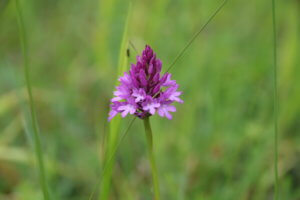
Pyramidal orchid in a wildflower meadow
Many of the best natural wildflower meadows thrive on poor soils. I live in the Chiltern Hills where chalk grasslands support a series of biodiverse meadow habitats replete with pretty wildflowers on the thin calcareous soils. I have a field like this very near my house where the grass is cut in late summer only and over the last few years ox-eye daisies and pyramidal orchids have colonised the site. This year I spotted my first Bee Orchids here.
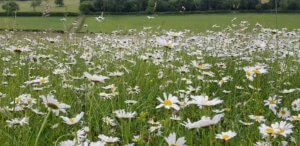
Another great example of this is the Ragpits Nature Reserve at Aston Clinton where a light touch management over 20 years has seen many common orchids recolonise a former chalk quarry.
Elsewhere, marshy meadows provide a different range of native flowers. Christ Church meadow in Oxford is sandwiched between the rivers Thames and Cherwell and can flood. Oxford University have reduced mowing here and have documented the plants that thrive, including cowslips, wood anemone, snakeshead fritillaries and marsh marigolds.
The low mow wildflower meadow
Aside from saving time behind the lawnmower, leaving your grass to grow gives native wildflowers a new habitat in your garden. Most of these will be common varieties but the habitats for many of these nectar rich flowers have reduced with the use of agricultural herbicides, neat-freak gardening techniques and “mow mow mow” public land management.
Not everyone enjoys the look of these and some neighbours can complain that an un-mown area is just a patch of weeds. Yet so many of our native flowers are very beautiful so changing the notion of what is a weedy patch as against a wildflower meadow zinging with life is an important trend.
Many local authorities have started to save money by adopting a low mow technique in public spaces and roadside verges. Some may complain that the result is messy but the benefits to wildlife in providing nectar for pollinators and habitats for breeding are well documented.
Some local authorities mow a narrow strip alongside busy roads, leaving the remainder unmown. A deer hit the car my husband was travelling in early one morning, killing the deer and writing off the car. It is clear that a strip of mown grass would have given both animal and driver vital extra seconds of visibility.
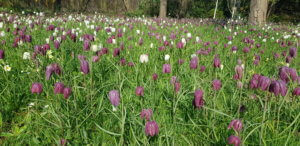
This established meadow of snakeshead fritillaries in my village encouraged me to try to get a colony going at home. It will only thrive if the grass is left long around it to allow it to set seed.
There are no such safety concerns in my orchard area and 3 years ago I took the decision to leave my grass long and see what happened, trusting that flowers would find their way in. My decision was partly driven by a desire to grow spring bulbs in the grass, mainly snakeshead fritillaries but the hope of providing an environment for other natives was also important.
If you haven’t got a large area you want to leave unmown you can leave an unmown strip or corner at the edge of your lawn.
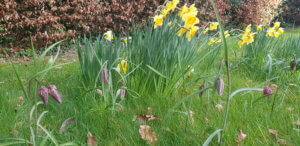
If you want to mow most of your lawn consider leaving a small strip or corner unmown. Plant with spring bulbs and leave these to die back and the grass grow long. Other wild flowers will move in to follow the bulbs.
Annual Seed Mix “wildflower” meadows
The second method is to deliberately sow mixes of annual flowers, some of which may be native to the UK, others not.
For those that choose to sow annual seed mixes in their gardens, it is possible to create a multi-coloured pretty flower patch in the first season. Reseeding every year may be needed if the plants grown don’t self seed easily. It is best not to sow directly into grass and ideally you would start with clear soil. I have tried this on a small piece of blank soil near my compost area and am awaiting the results.
There is definitely a place for these mixes as they can create big impact and colourful displays on any garden soil. There is a cost in buying the seeds of course but lots of choice from many seed suppliers.
A good example of this look is the banks in front of the visitor centre of Savill Garden in Windsor Great Park where an annual seed mix delivers a colourful welcome to visitors.
The trend has taken off in 2020 with part of the grounds of King’s College Cambridge sown with a colourful annual mix. A write up of the site and pictures of the preparations for seeding can be seen on the Cambridge University website.
The Sheffield based seed supplier Pictorial Meadows has championed this look. The organisation is a joint venture between the University of Sheffield and a social enterprise and combines seed supply with a design service. The enterprise is backed by years of research into suitable seed mixes by the renowned University of Sheffield Landscape Department.
Month by month low mow regime
May 2020 saw a new hashtag trending on twitter #NoMowMay. People shared their pictures of an area of their garden that they’d stopped mowing. Helpful as this was to spread the message, to create a wildflower area in your garden you really need to stop mowing for the summer months, and start again in early autumn. No Mow isn’t therefore a great description of what you need to do – low mow is probably preferable. Here’s my month by month guide with descriptions of the flowers that have arrived in my meadow area over 3 years.
January
The grass will still be short after its last autumn cut but on rare days that the temperature rises above 6 degrees centrigrade some growth will occur. Spring bulbs can be introduced to add colour in the dreary late winter. Crocus tomasianus is the first to arrive in my meadow area. A few bulbs were planted by the previous owner and they now carpet the entire orchard meadow area, spread by ants.
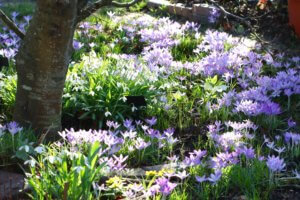
A carpet of crocus tomasianus in a wildflower area
February
The grass is still short and snowdrops take over. These are planted around the base of the fruit trees although they could be more widely disbursed. If you want to know more about introducing snowdrops to grassed areas click here for an article describing how to plant snowdrops into grass.
March and April
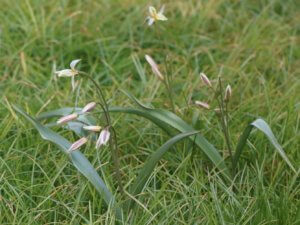
Tulipa turkestanica planted in a wildflower meadow
The months of narcissi. I have a few clumps of daffodils in my orchard meadow. As you’re not mowing you don’t need to worry about that messy period when the leaves are dying back to feed the bulbs. The grass will be growing up to cover the decaying leaves. Great daffodils to try are the Lent Lily, narcissus pseudonarcissus and the Hoop Petticoat Daffodil, narcissus bulbocodium.
I have also planted some species tulips here (most ornamentals do not compete well in grass). Tulipa turkestanica has multiple small flowers on each stem and interesting seed heads.
Late March and April sees the emergence of Snakeshead Fritillaries, fritillaria meleagris.
May
Depending in the warmth of spring the grass will have grown longer by now. In poorer soils the grass will be checked but in my fairly rich soil the grass is usually at knee height by May. Buttercups dot the grass with a yellow glow, their inner petals shiny as if coated in varnish.
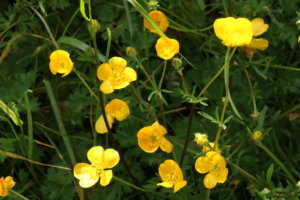
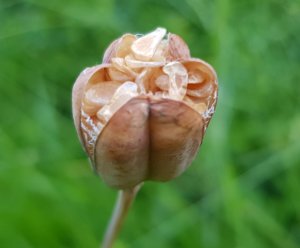
Snakeshead fritillary seedhead
Other flowers that have moved in here are vetch, speedwell and bugle. Lady’s Smock arrived in small numbers after a year of non mowing and now colonise the shadier damper areas. Tall cow parsley has also arrived but seems to prefer the edges of the meadow. In year 3 of non mowing, annual poppies have arrived and a few are dotted about. Snakeshead fritillary seedheads begin to pop.
June
Feverfew has developed into a large clump at the edge of a path, but not elsewhere. In the third year of low mowing the first common spotted orchid has arrived. For full disclosure I planted one small plant, given to me by a friend, in another part of the orchard.
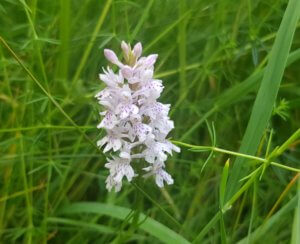
Common spotted orchid
It has disappeared but the arrival of a single flower elsewhere has made me wonder if somehow it flowered without me noticing and set seed, the result of which is clear to see. If not, the seed arrived here another way. Whatever the reason I am happy to see it.
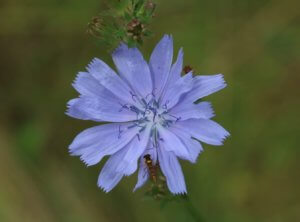
Chicory flower
I planted a few plug plants of chicory here two years ago and this begins to flower in late June with its pale Wedgewood blue flowers. Yellow rattle flowers now. I have attempted to sow this in my meadow area as it helps to compete with grass and can reduce the vigour of grass growth. So far the yellow rattle has failed to take hold, possibly because the winter of 2020 was warm and yellow rattle seed requires cold spells to germinate. I will sow more seeds in late autumn, possibly into a few areas cleared of grass.
July and August
By now the grass is beginning to dry out and can begin to collapse. Getting some yellow rattle established should reduce the vigour of the grass and prevent this happening. Leaving the grass until this time may still be slightly unsightly in my case but it’s worth it as I know that the seeds of all the lovely wildflowers and bulbs have a chance to ripen, drop and hopefully germinate at a later date.
September
You can mow in late august but I usually wait until early September. I say mow but we usually use a strimmer and then rake the clippings up. This gives the chance for any seeds to drop into the sward. It is tricky to mow long grass with a standard mower but if you do try it is worth not collecting the clippings in the box but to rake them to allow the seeds to drop.
October
Grass will continue to grow as long as the temperature remains above 6 degrees centigrade. You can continue to cut the grass until it stops growing so that you have a short green sward to show off your spring bulbs. If you want to get yellow rattle established sow seed according to the packet instructions, raking the ground beforehand. Alternatively, clear patches of grass to sow yellow rattle seed into to get established.
Good luck with creating your meadow.

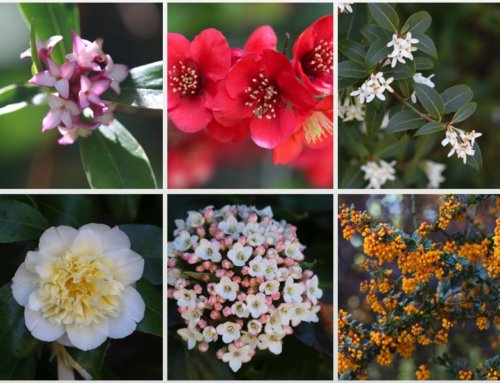
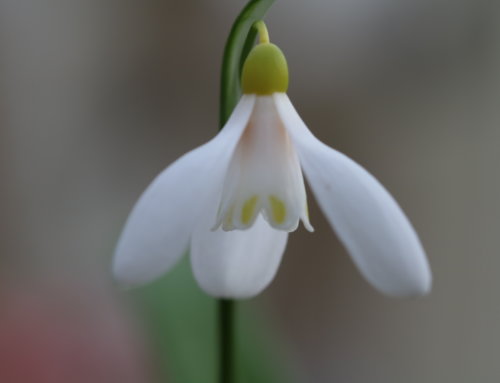
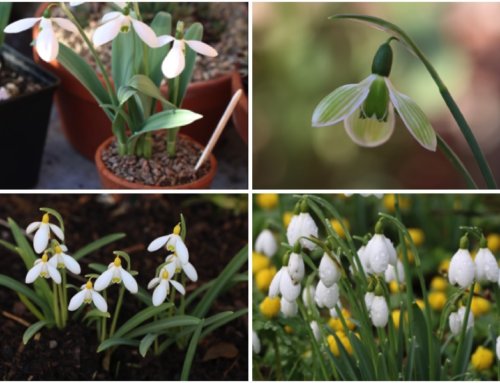
That’s looking lovely! How do you keep the dandelions down/out? They seem to be a dominant feature in my ‘wildflower’ area at the moment…
Hi Kate – there are some dandelions in there and I just leave them be as the insects love them. I think over time other flowers will find their way in to your area and the dandelions will be less dominant. I saw an amazing solution for dealing with the seedheads – set light to them. It’s great fun and they burn with a mini whoosh. That way the insects get the nectar but the seeds don’t disburse.
I read with interest your article, in our village we are trying to do more for wildlife and leave some areas unmown, sadly there are those who like to see a manicured village and are not willing to compromise. We are making small steps forward and I am trying to establish some new areas of wild flowers. I planted bulbs last autumn of snakes head fritillary, lent lily daffodils and bluebells, for some reason the fritillary have not appeared (wonder if I planted them too deep), but I will try more bulbs again this year.
Regarding yellow rattle I have managed to establish it in my garden in an area that stood in water last winter, but it was one of a few seeds that germinated in the wet conditions – so perhaps try it in a wet area.
Hi Ruth. I can see how balancing the views of everyone in a village will be very tricky. I do hope you get the fritillarias established – it’s definitely worth persevering as they just look fantastic when they get going. Thanks also for the tip on the yellow rattle. I have to admit I sowed most of them in the drier areas…
What a great article, very informative. I’ve sown some yellow rattle a few weeks ago, along with some spring bulbs, but as the grass is already starting to grow in parts, I’m just wondering will I need to give it a mow before the seedlings emerge? I’m worried about timing the cut with the bulbs too!
Hi Terri – I’m pretty sure that the yellow rattle needs a period of cold before germination, which would mean they would probably germinate in the spring. If you do decide to mow you probably could therefore but best do it with a mulching mow so as not to collect up the seeds in the collection box. Or you could go old school and use a scythe!
Thanks to the author for sharing such a great post. The article was very well written and create a wildflower meadow. It can be really great for people like me who are looking for grabbing more knowledge about it.
Glad you enjoyed it!
Hi when growing a wildflower patch how do I deal with slugs and snails
Thanks
Hi Sonia – I try no to worry too much about slugs and snails in this context. Many native species are untroubled by them anyway and I want this to be a wild area to encourage nature of all sorts into the garden. Hedgehogs love to eat slugs so my ideal would be to try and get a few hedgehogs in!
I planted yellow rattle last September after I cut the front lawn and there is masses of it now June has come. Also quite a lot of cuckoo flower which I didn’t plant, but I have seen it on grass verges near by. It’s a lovely addition.
The yellow rattle has grown in a very damp area after lots of rain. Can’t wait to see what comes up next!
It sounds like your patch is doing really well. My yellow rattle is really not doing as well but I’m optimistic I will get it established. Thanks for sharing news of your meadow area.